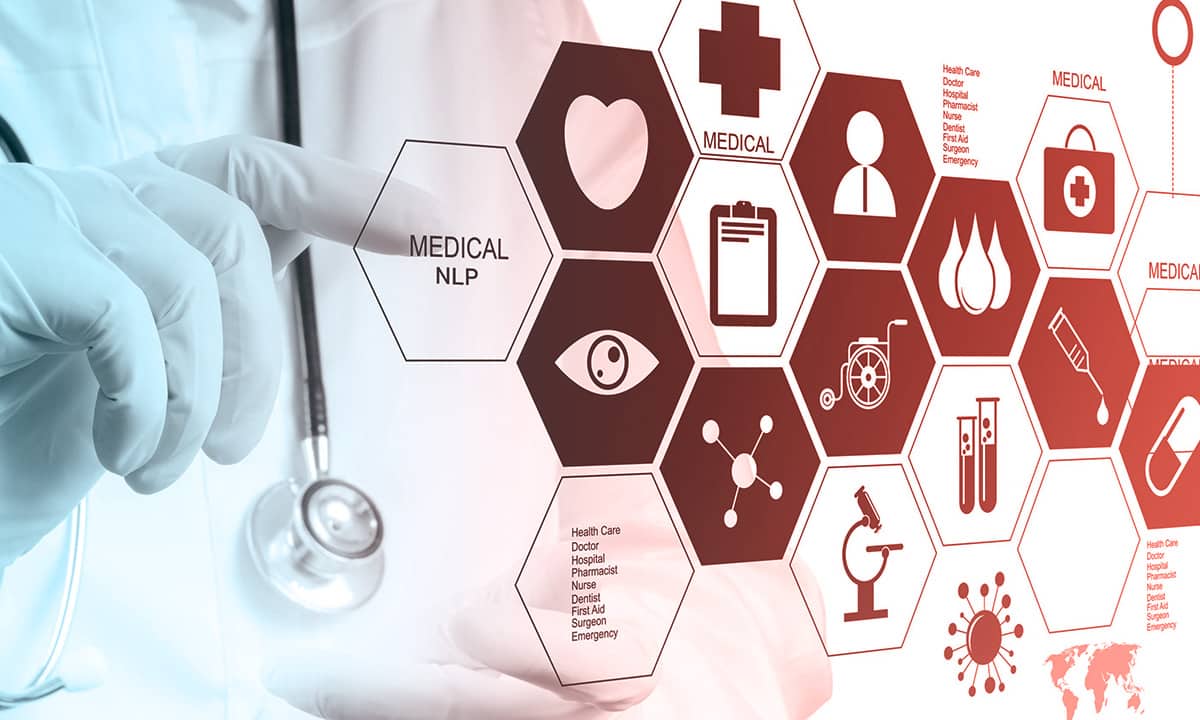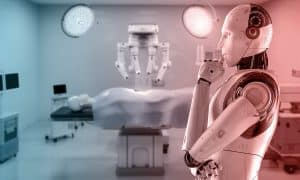The global Natural Language Processing (NLP) market in healthcare and life sciences has shown remarkable growth, reaching a substantial value of USD 4.78 billion in 2023. Industry experts project an impressive trajectory for this sector, with forecasts suggesting it will expand to approximately USD 50.15 billion by 2033. This represents a robust Compound Annual Growth Rate (CAGR) of 26.4% over the forecast period from 2024 to 2033. Such significant growth underscores the increasing importance and adoption of NLP technologies in transforming healthcare delivery, clinical research, and patient care.
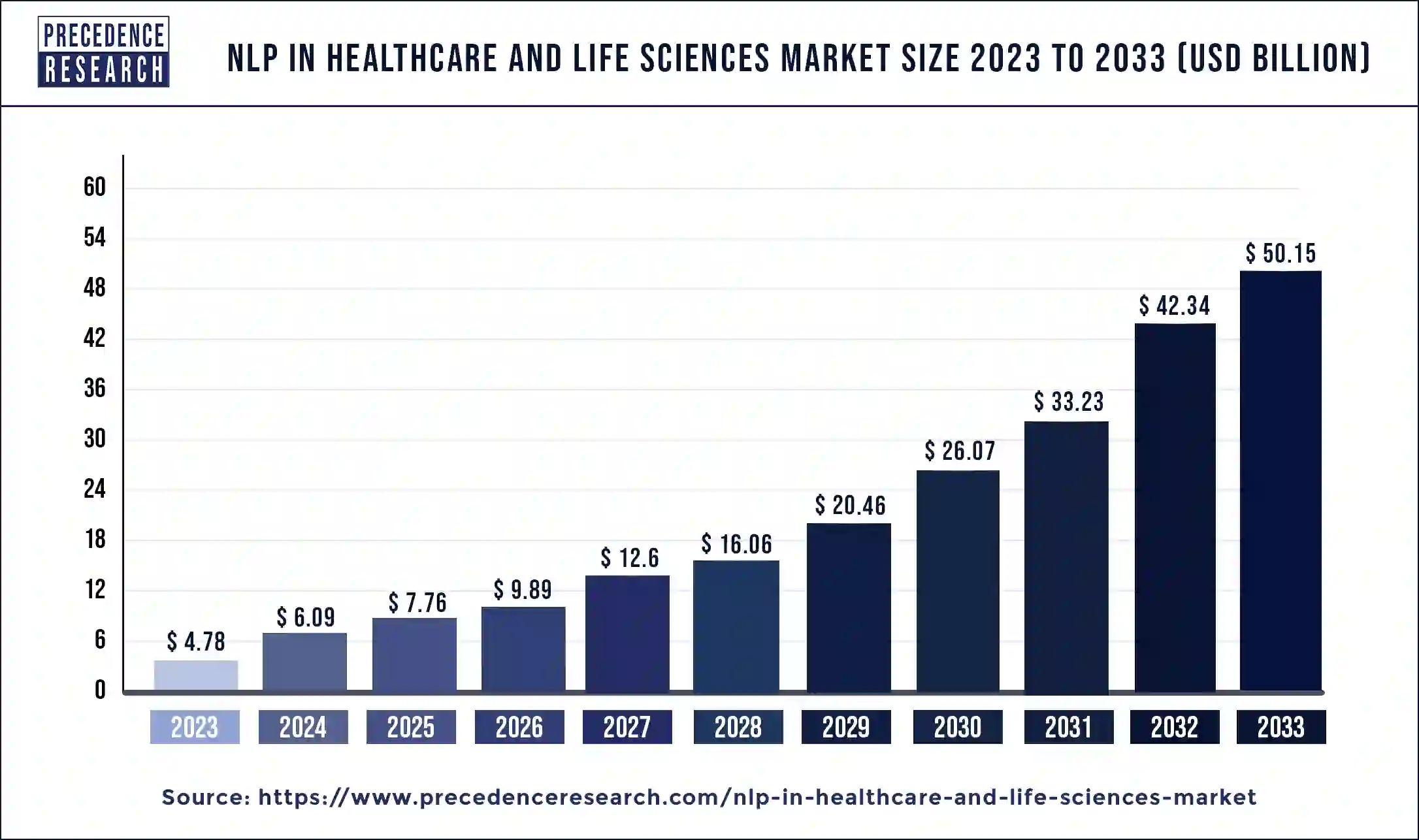
What is Healthcare NLP (Natural Language Processing)?
Healthcare NLP (Natural Language Processing) is a type of computer technology that helps machines understand and make sense of human language in medical settings. It’s like teaching computers to read and understand doctors’ notes, patient comments, and medical documents, just like a human would.
Simple Example:
Imagine a doctor writes a note about a patient:
“Mrs. Smith, a 45-year-old female, came in with a severe headache and slightly elevated blood pressure. Prescribed ibuprofen and recommended follow-up in two weeks.”
Healthcare NLP can automatically read this note and pick out important information:
Patient: Mrs. Smith
Age: 45
Gender: Female
Symptoms: Severe headache, slightly elevated blood pressure
Treatment: Prescribed ibuprofen
Next steps: Follow-up in two weeks
This technology can quickly go through thousands of such notes, helping to organize patient information, track treatments, and even spot patterns that humans might miss. It’s like having a super-fast medical assistant that can read and understand medical language, helping doctors and nurses focus more on caring for patients.
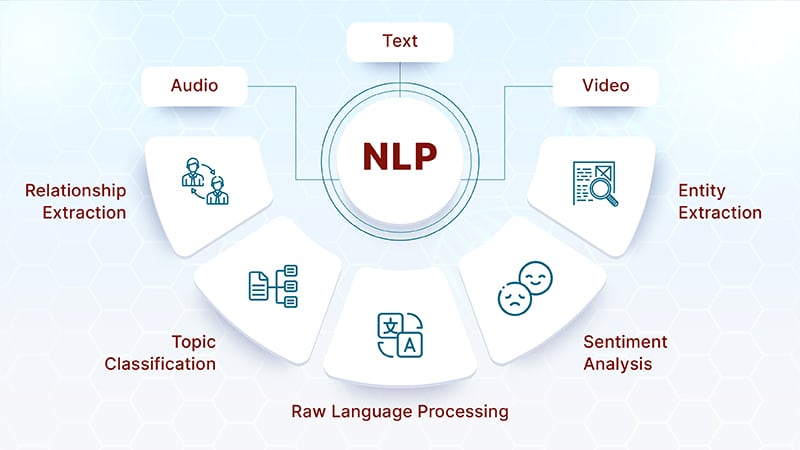
Who is using NLP in healthcare?
Many healthcare organizations, hospitals, and research institutions use Natural Language Processing (NLP) to improve patient care, streamline operations, and enhance research capabilities. This helps healthcare professionals including physicians, nurses, pharmacists, and administrators.
Companies like IBM Watson Health and Nuance are prominent examples that deploy NLP for clinical documentation, decision support, and patient engagement. These technologies allow for more efficient data management to reduce healthcare professionals’ time on paperwork. It leads to more time for patient care.
Research institutions and pharmaceutical companies employ NLP for drug development and clinical trials. It helps enhance patient selection and monitoring.
Additionally, startups and tech firms are innovating in automated coding, speech recognition, and virtual health assistants. They use NLP to analyze vast amounts of unstructured data, extract meaningful insights, and support decision-making processes.
The need to manage the increasing volume of data and the demand for personalized and efficient patient care drives the widespread adoption of NLP in healthcare.
Healthcare NLP Techniques You Should Know
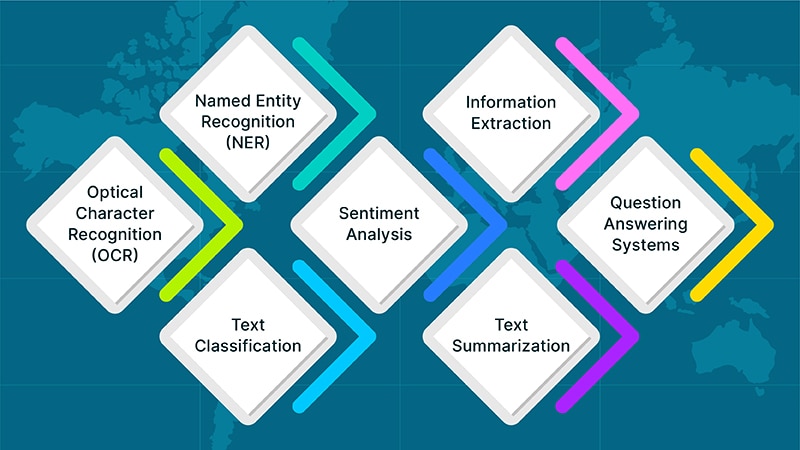
Optical Character Recognition (OCR)
OCR is the workhorse of document digitization in healthcare. It uses advanced image processing and machine learning algorithms to convert various types of medical documents – from handwritten notes to printed forms – into machine-readable text. It’s not just about recognizing characters; modern OCR systems employ contextual analysis and error correction to handle the complexities of medical terminology and abbreviations.
Named Entity Recognition (NER)
NER is a crucial information extraction technique in healthcare NLP. It uses sequence labeling algorithms, often implemented with Conditional Random Fields (CRFs) or deep learning models like Bidirectional LSTMs, to identify and classify medical entities in text. It can differentiate between diseases, symptoms, medications, and procedures, enabling structured data extraction from unstructured clinical notes.
Text Classification
In healthcare, text classification often employs supervised machine learning algorithms such as Support Vector Machines (SVMs) or deep learning models like Convolutional Neural Networks (CNNs). These models are trained on large corpora of labeled medical texts to categorize documents into predefined classes, such as different types of clinical reports or disease categories.
Sentiment Analysis
Healthcare sentiment analysis goes beyond simple positive/negative classification. It often involves aspect-based sentiment analysis to understand patient opinions on specific aspects of care. Techniques like BERT (Bidirectional Encoder Representations from Transformers) are used to capture context and nuance in patient feedback, enabling more accurate sentiment extraction.
Information Extraction
This technique uses a combination of rule-based systems and machine learning models to extract structured data from unstructured medical text. It often employs techniques like dependency parsing and semantic role labeling to understand the relationships between different entities in a text, allowing for the accurate extraction of complex medical information.
Text Summarization
In healthcare, both extractive and abstractive summarization techniques are used. Extractive methods often use graph-based algorithms like TextRank, while abstractive methods might employ sequence-to-sequence models with attention mechanisms. These techniques can distill key information from lengthy medical documents, aiding in quick information retrieval.
Question Answering Systems
Modern medical QA systems often use transformers-based models like BERT or GPT, fine-tuned on medical corpora. They employ techniques like document retrieval, passage ranking, and answer extraction to provide accurate responses to medical queries. Some advanced systems also incorporate reasoning capabilities to handle more complex medical questions.
Use Cases and Applications of NLP in the Healthcare Industry
Natural Language Processing (NLP) holds the power to automate tasks, improve accuracy, and offer insights that were previously difficult to obtain. It paves the way for a more efficient, accurate, patient-centered healthcare system. Let’s explore 12 important use cases where NLP makes a difference in healthcare.
- Clinical Documentation Improvement: NLP eases the burden of electronic health records for clinicians. It allows more patient interaction. New technologies enhance documentation with speech-to-text capabilities and make data collection at the point of care easier.
- AI Chatbots and Virtual Scribes: NLP-powered chatbots and virtual assistants provide real-time assistance, like symptom checking and scheduling appointments, to improve patient care.
- Advancing Speech Recognition: Speech recognition technology allows clinicians to transcribe notes efficiently for quicker data entry into electronic health records.
- Computer-Assisted Coding: CAC uses NLP to understand treatment data. This speeds up billing processes but needs further improvement in accuracy.
- Automated Registry Reporting: NLP automates the extraction of important values for regulatory reporting. It simplifies the documentation process for healthcare providers.
- Streamlining Clinical Trial Matching: NLP simplifies patient matching for clinical trials to make the selection process more efficient and effective.
- Simplifying Prior Authorization: NLP technologies are making the prior authorization process quicker to reduce administrative burdens on healthcare practices.
- Data Mining for Research: Integrating data mining with NLP helps healthcare organizations make objective decisions and provides valuable insights.
- Risk Adjustment with HCC Coding: NLP helps in accurate HCC coding by assigning risk scores based on ICD-10 codes. It helps you predict future healthcare costs.
- Review Management and Sentiment Analysis: NLP helps healthcare organizations manage online reviews, understand patient sentiments, and improve care based on feedback.
- Dictation and EMR Integration: NLP facilitates the transition from handwritten notes to digital records. It streamlines the documentation process and enhances patient care quality.
- Root Cause Analysis: Predictive analysis through NLP helps identify health disparities among different groups for targeted interventions.
What are Different Types of Clinical Data?
Clinical data includes various types of information vital for understanding patients’ health and the effectiveness of treatments. This data helps in making informed decisions in healthcare.
The collection of clinical data spans across different categories. Each category serves a unique purpose in improving healthcare outcomes.
Administrative Data
Administrative data deals with the logistics of healthcare. It includes patient admissions, discharge records, and billing information. This data aids in managing healthcare facilities efficiently. It ensures patients receive timely care while also optimizing the use of resources.
Claims Data
Claims data comes from the billing process of healthcare services. It provides details on the diagnoses, treatments, and procedures billed to health insurance companies. This data is crucial for analyzing healthcare costs and utilization. It helps in understanding the financial aspects of healthcare delivery.
Patient Disease Registries
Patient disease registries focus on collecting information about individuals diagnosed with specific diseases. These registries are essential for tracking the prevalence and outcomes of diseases. They provide data on the effectiveness of treatments over time to support research efforts.
Health Surveys
Health surveys collect data directly from individuals about their health, behaviors, and experiences with healthcare services. This type of data can help you understand public health trends. It also helps you identify areas needing improvement in healthcare systems.
Clinical Trial Data
Clinical trial data arises from research studies testing new treatments or interventions. This data is foundational for assessing the safety and efficacy of new medical approaches. It provides evidence on the best practices for treating various conditions to help with innovation in healthcare.
Each type of clinical data plays a pivotal role in enhancing healthcare. Together, they provide a comprehensive picture of health and healthcare delivery. They guide improvements in patient care and health policy.
Challenges of NLP implementation in healthcare
Implementing Natural Language Processing (NLP) in healthcare presents several challenges:
Data Complexity and Diversity
Healthcare data is complex and comes in various formats, including unstructured text such as clinical notes, prescriptions, and radiology reports. NLP systems must understand and process this wide range of data, which requires sophisticated algorithms.
Specific Language Requirements of the Healthcare Field
Healthcare professionals use a specific style in clinical notes and documents. They use heavy jargon, acronyms, and abbreviations, often with multiple meanings. For example, the term “discharge” can mean different things depending on the context.
Adapting NLP to accurately understand and process this specialized language requires significant training to familiarize the algorithms with the specific vocabulary used in healthcare settings.
Complexities of Human Language
NLP algorithms must navigate the complexities of human language, including inferences, the significance of semantics beyond mere keywords, and negation.
The challenge lies in enabling NLP models to do the following:
- Correctly interpret statements with implied meanings
- Differentiate between similar phrases with distinct semantics
- Accurately process negations without misconstruing the absence of a condition for its presence
Privacy and Security Concerns
Healthcare data is highly sensitive, and any system handling it must comply with strict regulations like HIPAA in the United States. It becomes a major challenge to ensure the privacy and security of patient data while using NLP.
Data Quality and Availability
The success of NLP applications depends on the quality and quantity of available data. Inconsistent documentation practices and incomplete records can hinder the effectiveness of NLP systems.
Bias and Explainability
Like all AI technologies, NLP can inherit biases from training on unbalanced datasets. It can lead to skewed recommendations or interpretations. For instance, AI models may exhibit gender bias, mistakenly associating genders with certain professions or underestimating the healthcare needs of certain demographic groups due to historical data biases.
Integration with Existing Systems
Integrating NLP technologies into existing healthcare IT systems and workflows can be challenging. Significant effort and resources are required to ensure seamless operation without disrupting current practices.
Scalability and Adaptability
As healthcare evolves, NLP systems must adapt to new treatments, terminologies, and regulations. Ensuring these systems are scalable and quickly adjust to changes is a significant challenge.
Overcoming these challenges requires concerted efforts from technology providers, healthcare professionals, and regulatory bodies. It involves continuous improvement of NLP technologies, adherence to high data privacy standards, and fostering collaboration across the healthcare ecosystem.
Step-by-step implementation of natural language processing in healthcare
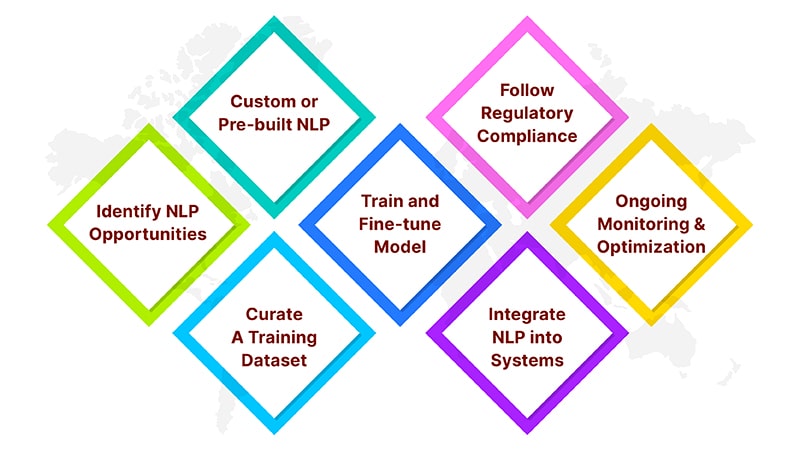
Adopting Natural Language Processing (NLP) in the healthcare industry can significantly enhance patient care and operational efficiency. Here’s a structured approach to integrating NLP technologies within healthcare settings:
Identify NLP Opportunities in Healthcare
Begin by pinpointing specific challenges within your healthcare organization that NLP can address. Consider areas where NLP can add value, such as:
- Improving patient outcomes through better disease prediction models
- Enhancing the efficiency of medical coding
- Facilitating more accurate patient feedback analysis
Choose Between Custom and Pre-built NLP Solutions
Decide whether a pre-built NLP solution meets your needs or if a tailored approach is necessary. Pre-built solutions offer cost-effectiveness and quicker deployment but may lack the flexibility for specific healthcare contexts. While more resource-intensive, custom solutions allow for greater scalability and integration with existing healthcare systems.
Curate a Training Dataset
A crucial step is preparing a comprehensive and unbiased dataset to train your NLP model. This dataset should accurately reflect the linguistic nuances of the healthcare field, including the diverse ways patients describe symptoms and the specific terminology used by healthcare professionals.
Train and Fine-tune Your NLP Model
After selecting your NLP solution, train the model with your curated dataset. This phase is critical for ensuring the model’s accuracy and ability to handle healthcare-specific language nuances. You must incorporate rigorous validation against known outcomes to assess performance.
Follow Regulatory Compliance
For NLP applications in healthcare, compliance with regulations such as HIPAA in the U.S., GDPR in Europe, and other relevant standards is non-negotiable. You must ensure your NLP solution meets patient privacy and data security regulations.
Integrate NLP into Healthcare Systems
Integrating the NLP solution into existing healthcare IT infrastructure requires careful planning. If you’re working with a custom solution, your technology partner should assist in this integration. It ensures minimal disruption to existing workflows.
Ongoing Monitoring and Optimization
Post-deployment, continuous monitoring of the NLP system is necessary to ensure it performs as expected. Be prepared to adjust and retrain the model as healthcare practices evolve and new data becomes available. It helps ensure the NLP system remains effective and relevant.

